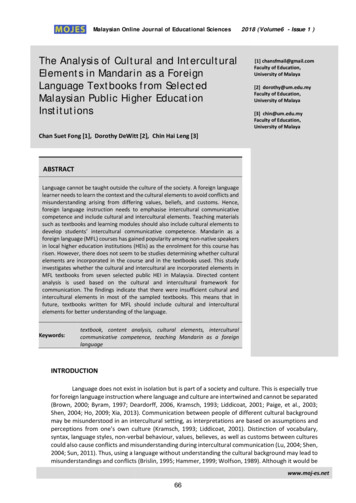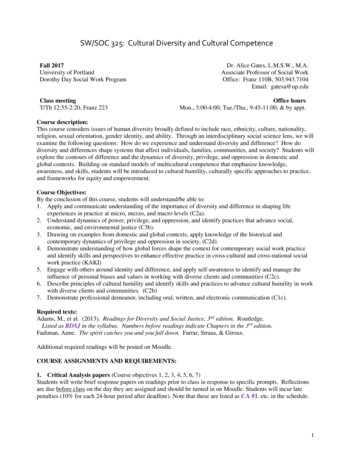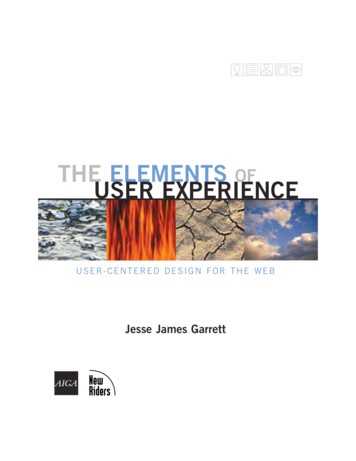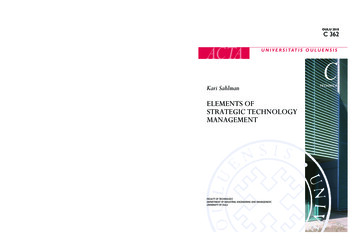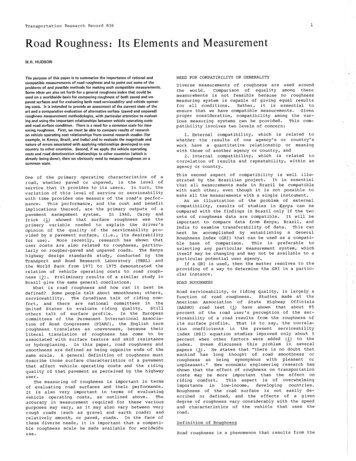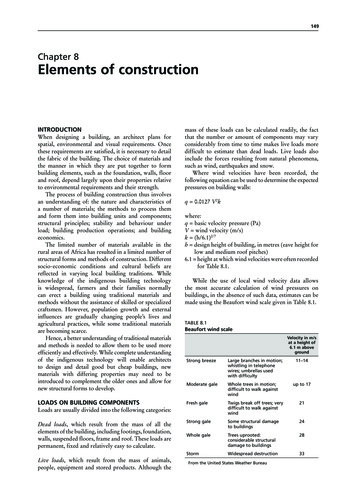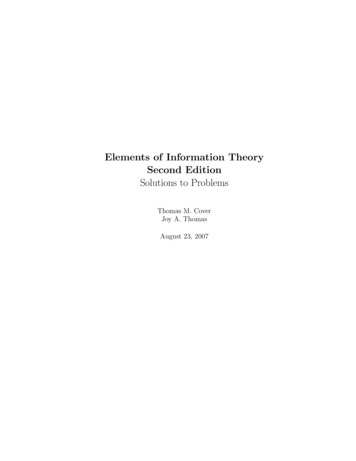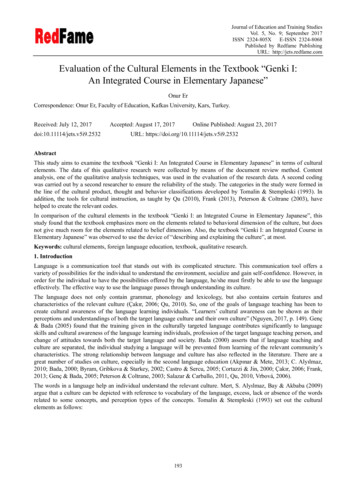
Transcription
Journal of Education and Training StudiesVol. 5, No. 9; September 2017ISSN 2324-805X E-ISSN 2324-8068Published by Redfame PublishingURL: http://jets.redfame.comEvaluation of the Cultural Elements in the Textbook “Genki I:An Integrated Course in Elementary Japanese”Onur ErCorrespondence: Onur Er, Faculty of Education, Kafkas University, Kars, Turkey.Received: July 12, 2017doi:10.11114/jets.v5i9.2532Accepted: August 17, 2017Online Published: August 23, 2017URL: s study aims to examine the textbook “Genki I: An Integrated Course in Elementary Japanese” in terms of culturalelements. The data of this qualitative research were collected by means of the document review method. Contentanalysis, one of the qualitative analysis techniques, was used in the evaluation of the research data. A second codingwas carried out by a second researcher to ensure the reliability of the study. The categories in the study were formed inthe line of the cultural product, thought and behavior classifications developed by Tomalin & Stempleski (1993). Inaddition, the tools for cultural instruction, as taught by Qu (2010), Frank (2013), Peterson & Coltrane (2003), havehelped to create the relevant codes.In comparison of the cultural elements in the textbook “Genki I: an Integrated Course in Elementary Japanese”, thisstudy found that the textbook emphasizes more on the elements related to behavioral dimension of the culture, but doesnot give much room for the elements related to belief dimension. Also, the textbook “Genki I: an Integrated Course inElementary Japanese” was observed to use the device of “describing and explaining the culture”, at most.Keywords: cultural elements, foreign language education, textbook, qualitative research.1. IntroductionLanguage is a communication tool that stands out with its complicated structure. This communication tool offers avariety of possibilities for the individual to understand the environment, socialize and gain self-confidence. However, inorder for the individual to have the possibilities offered by the language, he/she must firstly be able to use the languageeffectively. The effective way to use the language passes through understanding its culture.The language does not only contain grammar, phonology and lexicology, but also contains certain features andcharacteristics of the relevant culture (Çakır, 2006; Qu, 2010). So, one of the goals of language teaching has been tocreate cultural awareness of the language learning individuals. “Learners’ cultural awareness can be shown as theirperceptions and understandings of both the target language culture and their own culture” (Nguyen, 2017, p. 149). Genç& Bada (2005) found that the training given in the culturally targeted language contributes significantly to languageskills and cultural awareness of the language learning individuals, profession of the target language teaching person, andchange of attitudes towards both the target language and society. Bada (2000) asserts that if language teaching andculture are separated, the individual studying a language will be prevented from learning of the relevant community’scharacteristics. The strong relationship between language and culture has also reflected in the literature. There are agreat number of studies on culture, especially in the second language education (Akpınar & Mete, 2013; C. Alyılmaz,2010; Bada, 2000; Byram, Gribkova & Starkey, 2002; Castro & Sercu, 2005; Cortazzi & Jin, 2000; Çakır, 2006; Frank,2013; Genç & Bada, 2005; Peterson & Coltrane, 2003; Salazar & Carballo, 2011, Qu, 2010, Vrbová, 2006).The words in a language help an individual understand the relevant culture. Mert, S. Alyılmaz, Bay & Akbaba (2009)argue that a culture can be depicted with reference to vocabulary of the language, excess, lack or absence of the wordsrelated to some concepts, and perception types of the concepts. Tomalin & Stempleski (1993) set out the culturalelements as follows:193
Journal of Educcation and Trainning StudiesVol. 55, No. 9; Septemmber 2017Figure 1. Elemeents of Culturee (Tomalin andd Stempleski, 11993, p. 7)As seen in Figgure 1, Tomalin & Stemplesski (1993) evaaluated the cultture under threee dimensionss: product, thouught andbehavior. Subb-elements off the productt dimension include literaature, folkloree, art, music and artefacts, whilesub-elements of the thoughht dimension iis introduced aas beliefs, vallues and instittutions. Finallyy, sub-elementts of thebehavior dimeension consist of customs, haabits, dress, foods and leisure.Teacher is thee person who canc express cuultural elementts and make hiis/her studentss feel it. Thereefore, the teachher has aduty to ensurre the studentss to establish a relationshipp between theeir own culturre and the targget language’ss culture(Byram, Gribkkova & Starkeey, 2002, Casttro & Sercu, 2005). Howeveer, the teacher must use various materials to fulfillthis task. In tthis regard thee teacher makees use of the relevant textbook, at first. CCortazzi & Jinn (2000) identtifies thetextbook as onne of the dimennsions of the ccultural awarenness-building pprocess in langguage teachingg.Many books rrelated to Japaanese and Japaanese culture as well as Chinnese and Chineese culture hass been examineed in therelevant literaature (Wierzbiicka, 2006). WWang (2006) sstated that the increase in thhe number off textbooks wrritten forChinese teachhing leads to confusion in mminds. Thereforre, the extra ammount of textbbooks written for a second languagelteaching placees an extra respponsibility on a language teaacher. Becausee the teacher shhould be able to choose the textbooktthat will be mmost useful to his/herhstudentss. For this reasson, the researrches deeply exxamining the ttextbooks shouuld guidethe teachers. EExamining thee Genki I textbbook in a cultuural perspectivee in details, thhis study tries tto provide the teacherswith an idea aabout choosingg a textbook.This study aimms to examinee the textbook “Genki I: An Integrated Coourse in Elemeentary Japanesse” in terms off culturalelements. Thee cultural elements in the texttbook of Genkki I: an Integratted Course in EElementary Jaapanese were evaluatedewithin the scoope of this preesent study. Thhe cultural eleements createdd by Tomalin & Stempleskii (1993) were taken asbasis in the evvaluation of thee cultural elemments stated in the textbook iin question.The study seekks to answer thhe following qquestions:How does prooduct dimensioon of the cultuure take place iin in the textbook “Genki I: an Integrated Course in EleementaryJapanese”?ementaryHow does thoought dimensioon of the cultuure take place iin in the textbook “Genki I: an Integrated Course in EleJapanese”?How does behhavior dimensiion of the cultuure take place in in the textbbook “Genki I:: an Integratedd Course in EleementaryJapanese”?ementaryWhat are the devices used to create cultuural awarenesss in the textboook “Genki I: an Integrated Course in EleJapanese”?2. Method2.1 Research MModelThis study waas performed inn screening mmodel and desiggned accordingg to the qualitaative method iin order to evaluate thecultural elemeents in the texttbook of Genkki I: an Integraated Course in Elementary Jaapanese. Quallitative research can bedefined as a reesearch followwing qualitativee process in wwhich the qualittative data colllection methodds such as obseervation,interview andd document annalysis are useed, and the reelevant phenommena and eveents are presennted in a realiistic andholistic manneer in their natuural environmeents (Yıldırım & Şimşek, 20008, p. 39).194
Journal of Education and Training StudiesVol. 5, No. 9; September 20172.2 The Examined TextbookThe textbook “Genki I: an Integrated Course in Elementary Japanese” (English parts and images) was examined in thepresent study. This textbook aims to teach Japanese as a second language at the beginner level. There are 12 chapters inthe textbook, and cultural notes at the end of each chapter.2.3 Data CollectionThe research data were collected from the textbook of Genki I: an Integrated Course in Elementary Japanese, using thedocument review method as one of the qualitative data collection methods. “Document review includes analysis of thewritten materials that contain information about the facts or phenomena targeted for investigation” (Yıldırım & Şimşek,2008, p. 187).2.4 Data AnalysisContent analysis from the qualitative analysis techniques was used in evaluation of the research data. “The main goal incontent analysis is to reach the concepts and associations that can explain the collected data. The basic process incontent analysis is to put together similar data within the framework of specific concepts and themes, and interpret themin a way that the reader can understand” (Yıldırım & Şimşek, 2008, p 227). The textbook was read in the research andthen the coding was done in a general framework. Later, the categories, themes and codes were created based on thecultural elements generated by Tomalin & Stempleski (1993) and the cultural awareness devices specified by Qu (2010),Frank (2013), Peterson & Coltrane (2003). Images in the textbook have also been analyzed in terms of culture. Yıldırım& Şimşek (2008) and Merriam (2013) stated that visual materials are among the document types, so they can be used inqualitative researches.The codes and themes of the two researchers were compared in order to ensure reliability of the research and confirmwhether the codes contained in the obtained themes have corresponded to the themes in question. Miles & Huberman's(1994) Reliability (number of agreements / total number of agreements disagreements) x100 formula was used toensure the reliability of the data obtained by the content analysis method applied in the research. The reliability amongthe researchers was found to be .93 using this formula. The codes leading a disagreement between the two researcherswere discussed and then placed under appropriate themes.3. ResultsThe categories, themes and codes obtained from the textbook that was examined in the direction of the researchquestions are presented in this section by using the following tables.Table 1. Themes and codes of the cultural elements in product dimension of the culture in genki I textbookGenki I: An Integrated Course in Elementary JapaneseThemes and CodesThemes and Codes by the Textbook SectionAlphabetSection including Alphabet ThemeHiraganaJapanese Writing SystemKanjiJapanese Writing SystemKatakanaJapanese Writing SystemArchitectureSection including Architecture ThemeJapanese HousesCulture NotesShurei Gate on 2,000-yen billCulture NotesFolkloreSection including Folklore ThemeJapanese FolktaleThe Folktale KasajizoKabuki TheaterKabuki and Culture NotesPuppet TheaterCulture NotesHumorous StorytellingCulture NotesMasked Musical DramaCulture NotesLiteratureSection including Literature ThemeA portrait of Ichiyoo Higuchi on 5,000-yen billCulture NotesPhilosophySection including Philosophy ThemeA portrait of Yukichi Fukuzawa on 10,000-yen bill Culture NotesScienceSection including Science ThemeA portrait of Hideyo Noguchi on 10,000-yen billCulture NotesSportSections including Sports ThemeSumo WrestlingCulture NotesJudoCulture NotesJapanese FencingCulture Notes195
Journal of Education and Training StudiesVol. 5, No. 9; September 2017As seen in Table 1, the themes including alphabet, architecture, folklore, literature, philosophy, science and sports thatare related to the product dimension were obtained in the textbook of Genki I: an Integrated Course in ElementaryJapanese.The codes including Hiragana, Kanji and Katakana were obtained under the alphabet theme. These codes are located inthe “Japanese Writing System” section. Here is a sample part where the Hiragana and Katakana codes were obtained:Hiragana and Katakana, like the alphabet, represent sounds. As you can see in the above example, hiragana has aroundish shape and is used for conjugation endings, function words, and native Japanese words not covered by kanji.Katakana, which has rather straight lines, is normally used for writing loanwords and foreign names. (Banno, Ikeda,Ohno, Shinagawa & Tokashiki, 2011, p. 24).The codes including “Japanese Houses and Shurei Gate on 2,000-yen bill” were obtained under the folklore theme. Thesecodes are located in the “Culture Notes” section. Here is a sample part where the “Japanese Houses” code was obtained:Traditionally, Japanese buildings were made of wood. Rooms were floored with tatami (rice-straw mats) and divided byfusuma or shooji (two types of sliding doors). Modern Japanese houses have mainly Western-style rooms, and areequipped with Western-style toilets. (Banno et al., 2011, p. 101).The codes including “Japanese Folktale”, “Kabuki Theater”, “Puppet Theater”, “Humorous Storytelling” and “MaskedMusical Drama” were obtained under the architecture theme. The “Japanese Folktale” and “Kabuki Theater” codes arelocated in “The Folktale Kasajizo” and “The Kabuki and Culture Notes” sections, respectively. Moreover, the codesincluding “Puppet Theater”, “Humorous Storytelling” and “Masked Musical Drama” are located in the “Culture Notes”section. Here is a sample part where the “Kabuki” code was obtained:Takeshi: Mary, do you like Kabuki?Mary: Kabuki? I don’t know it well. But Robert said it was interesting.Takeshi: I got two tickets for Kabuki, so would you like to go to see it?Mary: Sure. When is it?Takeshi: On Thursday. From twelve noon to four. (Banno et al., p. 209).The “A portrait of Ichiyoo Higuchi on 5,000-yen bill” code was obtained under the literature theme. This code islocated in the “Culture Notes” section. Here is a sample part where the “A portrait of Ichiyoo Higuchi on 5,000-yen bill”code was obtained:A portrait of Ichiyoo Higuchi (1872-1896), a writer and poet (Banno et al., p. 68). The “A portrait of Yukichi Fukuzawaon 10,000-yen bill” code was obtained under the philosophy theme. This code is locat
“Genki I: An book of Genk e cultural ele ents stated in uestions: re take place i re take place i re take place ral awareness odel and desig i I: an Integra process in w d, and the re nts (Yıldırım 194 (Tomalin and luated the cult include litera s beliefs, val ods and leisur s and make hi between the 005). Howeve relevant textb ess-building p s well as Chin tated that the e, the extra am .
